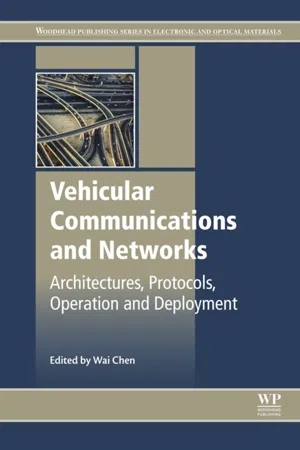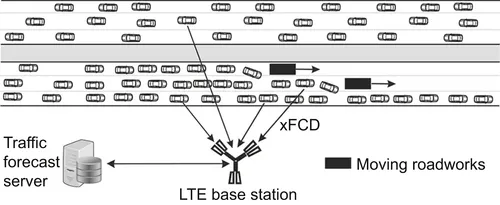
eBook - ePub
Vehicular Communications and Networks
Architectures, Protocols, Operation and Deployment
- 324 pages
- English
- ePUB (mobile friendly)
- Available on iOS & Android
eBook - ePub
About this book
Vehicular Communications and Networks: Architectures, Protocols, Operation and Deployment discusses VANETs (Vehicular Ad-hoc Networks) or VCS (Vehicular Communication Systems), which can improve safety, decrease fuel consumption, and increase the capacity of existing roadways and which is critical for the Intelligent Transportation System (ITS) industry. Part one covers architectures for VCS, part two describes the physical layer, antenna technologies and propagation models, part three explores protocols, algorithms, routing and information dissemination, and part four looks at the operation and deployment of vehicular communications and networks.
- Comprehensive coverage of the fundamental principles behind Vehicular Ad-hoc Networks (VANETS) and the rapidly growing need for their further development
- Thorough overview of the design and development of key technologies and devices
- Explores the practical application of this technology by outlining a number of case studies, testbeds and simulations employing vehicular communications and networks
Frequently asked questions
Yes, you can cancel anytime from the Subscription tab in your account settings on the Perlego website. Your subscription will stay active until the end of your current billing period. Learn how to cancel your subscription.
At the moment all of our mobile-responsive ePub books are available to download via the app. Most of our PDFs are also available to download and we're working on making the final remaining ones downloadable now. Learn more here.
Perlego offers two plans: Essential and Complete
- Essential is ideal for learners and professionals who enjoy exploring a wide range of subjects. Access the Essential Library with 800,000+ trusted titles and best-sellers across business, personal growth, and the humanities. Includes unlimited reading time and Standard Read Aloud voice.
- Complete: Perfect for advanced learners and researchers needing full, unrestricted access. Unlock 1.4M+ books across hundreds of subjects, including academic and specialized titles. The Complete Plan also includes advanced features like Premium Read Aloud and Research Assistant.
We are an online textbook subscription service, where you can get access to an entire online library for less than the price of a single book per month. With over 1 million books across 1000+ topics, we’ve got you covered! Learn more here.
Look out for the read-aloud symbol on your next book to see if you can listen to it. The read-aloud tool reads text aloud for you, highlighting the text as it is being read. You can pause it, speed it up and slow it down. Learn more here.
Yes! You can use the Perlego app on both iOS or Android devices to read anytime, anywhere — even offline. Perfect for commutes or when you’re on the go.
Please note we cannot support devices running on iOS 13 and Android 7 or earlier. Learn more about using the app.
Please note we cannot support devices running on iOS 13 and Android 7 or earlier. Learn more about using the app.
Yes, you can access Vehicular Communications and Networks by Wai Chen in PDF and/or ePUB format, as well as other popular books in Technology & Engineering & Automotive Transportation & Engineering. We have over one million books available in our catalogue for you to explore.
Information
Part One
Architectures for vehicular communication systems
1
Vehicle-to-infrastructure communications
C. Wietfeld, and C. Ide TU Dortmund University, Communication Networks Institute, Dortmund, Germany
Abstract
The chapter discusses challenges and solution approaches for the usage of cellular communication systems for vehicle-to-infrastructure (V2I) applications. This includes a general introduction to V2I applications, a detailed performance evaluation of long-term evolution (LTE)-based mobile networks regarding velocity-dependent data rates and an analytical system model for the evaluation of the interaction between V2I communications and LTE human traffic. Finally, the chapter discusses a new channel-aware, decentralized transmission scheme that decreases the negative impact of V2I communications on the quality of service of human services.
Keywords
Long-term evolution (LTE); Machine-type communications; Performance evaluation; V2I communications1.1. Introduction
Due to the increasing amount of mobile data applications, vehicle-to-infrastructure (V2I) communications has become a recent topic in the development of wireless communication systems. More and more V2I services are carried by cellular communication systems because the potential of cellular systems in terms of data rate and delay has increased significantly by the introduction of long-term evolution (LTE). This chapter discusses challenges and solution approaches for the usage of cellular communication systems (with focus on LTE) for V2I applications. This includes a general introduction to V2I applications and its requirements, a performance evaluation of LTE regarding velocity-dependent data rate measurements and a system model for the evaluation of the interaction between V2I communications and LTE human traffic. The system model is based on a close-to-reality parameterized Markovian resource model. For the parameterization the laboratory-based LTE data rate measurements and ray tracing analyses are used. The chapter finally discusses a channel-aware transmission scheme for V2I applications. It is shown that this algorithm decreases the negative impact of V2I communications on the quality of service (QoS) of human services in terms of blocking probability. In addition, it is illustrated that the inserted delay by the channel-aware transmission scheme is tolerable for many V2I applications.
1.2. V2I applications, requirements and related work
In this section, vehicular applications in the context of traffic management, traffic forecast and fleet management will be introduced. This also includes novel safety applications that require very low delays.
1.2.1. Traffic management and forecast systems
Traffic management and forecast systems are traditional based on static sensors inside the road network. These sensors identify the number of vehicles per lane and the velocity of the cars. Typically, the information is not transmitted for every single vehicle, but the traffic management system gets the information about the average velocity for all vehicles in a period of time. This time is often about 1 minute. In order to forecast the traffic situation, the real-time measurement data can be combined with historical data for the same time on the same day of the week. In order to provide a more reliable and detailed prognosis, modern dynamic traffic forecast systems are based on floating car data (FCD) (Kerner et al., 2005). Typically, these data contain global positioning system (GPS) and velocity information from the navigation system or a smartphone in the vehicle. Several percent penetration rate is necessary for a good traffic state estimation (Ide, Knaup, et al., 2012; Vadenberghe, Vanhauwaert, Verbrugge, Moerman, & Demeester, 2012). By means of the FCD, the forecast of the traffic density is possible, but the relationship between traffic flow and density is not bijective. This means that for the same density different flows are possible. This is due to the fact that the flow is also dependent on further parameters (e.g. driver behaviour, road conditions, etc.). In Al-Sultan, Al-Bayatti, and Zedan (2013) an approach for detecting the driver behaviour based on local information is presented. This additional information is important to detect very complex traffic situations, for example, moving day roadworks (cf. Figure 1.1), heavy goods transport or situations where the average velocity between different lanes varies significantly. To make the forecast more reliable or to enable further applications like dynamic route guidance, road weather information services or local danger alarms, it is necessary to collect more information from the vehicles. The so-called extended floating car data (xFCD) (Huber, Lädke, & Ogger, 1999) include, for example, information from the autonomous cruise control, the rain sensor (from a controller area network (CAN) bus) or an in-vehicle camera to detect the current traffic situation more precisely (Diaz et al., 2012) and to enable a better forecast. The delay requirements of the xFCD are in most situations very low (except for safety critical situations like an accident). Table 1.1 provides possible xFCD with its functionality and the approximated payload size. By means of this information, also fleet management systems, e.g. in order to optimize the transport energy (Ma & Martensson, 2012), can be supported.
The information content of the xFCD collected in the vehicles is dependent on two different attributes: the relevance (e.g. slow vehicles on an interstate, strong braking) and the degree of novelty of the data. The novelty of the data considers the fact that the vehicle is aware of the proposed traffic state from the forecast system. For example, if a vehicle is driving very slowly on an interstate, the data are of course relevant, but the novelty depends on the expected traffic state from the forecast system, whether it provides to the vehicles that the interstate is free (in many systems marked with a green colour) or whether the system knows that there is a traffic jam (in many systems marked with a red colour).

Figure 1.1 Moving roadwork scenario with long-term evolution (LTE)-enabled vehicle-to-infrastructure (V2I) communications. Source: Adapted from Ide, Habel, Knaup, Schreckenberg, and Wietfeld (2014).
Table 1.1
xFCD with function and appr...
Table of contents
- Cover image
- Title page
- Table of Contents
- Related titles
- Copyright
- List of contributors
- Woodhead Publishing Series in Electronic and Optical Materials
- Part One. Architectures for vehicular communication systems
- Part Two. Protocols, algorithms, routing and information dissemination for vehicular networks
- Part Three. Operation and deployment of vehicular communications and networks
- Index